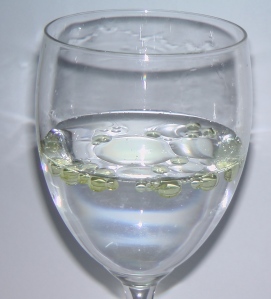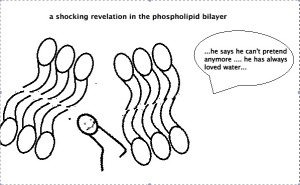Posts Tagged hydrophilic
Border security force
Posted by paulramesh in Uncategorized on August 2, 2014
Like all walls it was ambiguous, two faced. What was inside it and what was outside it depended upon which side you were on.
―Ursula LeGuin The Dispossessed.
Without the lipid bilayer we would have no physical shape. In fact, we would be little more than a puddle of chemicals on the floor.
– Crowe, Bradshaw, Monk, Chemistry for the Biosciences – The essential concepts
Love and hate in equal measure
In probably one of the most important divisions between oneself and the other is the definition of the cell and its external environment.
The physical structure that makes this distinction is the cell membrane.
How does the cell membrane divide the inside of the cell from the outside?
Our bodies and our cells are effectively made up mostly of water. The most likely place for the origin of life is an aqueous environment.
One of the most important properties of water is its polarity. for details please see the blog on water – nectar of life.https://paulramesh.wordpress.com/2014/01/05/water-nectar-of-the-gods/
At its most basic structure the cell membrane is described as a lipid bilayer.
The organic molecule that constitutes the cell membrane is called glycerophospholipid. It has a carbohydrate part called glycerol, a fatty acids part and a phosphate and protein part.
The phosphate part is polar in nature. This means that it interacts well with water, which in turn means that it forms hydrogen bonds with water. This part of the molecule is called hydrophilic which means water loving.
The fatty acid part is set to be non polar in nature. This means it does not interact with water to form hydrogen bonds and indeed leads to disruption of the hydrogen bonds that exist between water molecules.
In order to preserve stability of molecule and water, the the water loving part orients away from the water hating part. The molecule in effect folds and aligns in such a way that the water loving part faces the water (the hydrophilic head) and the water hating part lies together away from the water (the hydrophobic tail).
This is also the reason why oil and water do not mix.
This is the basis for the lipid bilayer of the cell membrane .http://www.occc.edu/biologylabs/Images/Cells_Membranes/plasmamembrane2.jpg
Customs and immigration
The primary function of the plasma membrane is similar to a border security force. It regulates what can get into the cell, and how much of it, what can get out of the cell. It is a dynamic and complex structure – not just a barrier.Cholesterol – which has over the years gained a bad reputation in health matters – is an integral part of the membrane – indeed it is vital for its function and is found inserted between the lipid bilayer.
The cell membrane is a very fluid structure and is far more than just a bilayer and cholesterol. There are protein structures that traverse its length – the integral proteins, they were thought to move like icebergs in a lipid sea. it is now believed that the movement is not random but goal directed.
Molecules can pass into and out of a cell in a variety of ingenious ways.
- Simple diffusion – certain small uncharged molecules have a green channel and can just go across the membrane provided their concentrations inside the cell are lower.
- Some have to be transported across the membrane via carrier proteins, the molecule gets onto a defined integral protein that changes shape and carries it to the inside of the cell. If this process requires energy – it is called active transport such as for hydrogen ions as they have to be carried against their concentration gradient , if no energy is required e.g.. Glucose it called passive transport.
- Ion selective channels – here the protein is specific for the ion that it will transport into the cell, it is controlled by electric potential (voltage gated), chemical transmitters (ligand-gated), mechanical stress (mechanical gated e.g. in the ear) and light see blog on light.
- The integral proteins can be receptors for hormones – so the arrival of a hormone can induce changes in the receptor and trigger changes on the inside of a cell and thus control its function.
- They can be enzymes that catalyse reactions at the membrane or inside in response to stimuli
- They also link the internal scaffold of the cell (the cytoskeleton) to the external scaffold ( the extracellular matrix). the complexities of this relationship are only now being studied in detail.
- Molecules can be transported inside by the cell membrane just engulfing and ingesting them – endocytosis. this happens to bacteria when they are attacked by your immune cells.
- The products of say an endocrine gland may need to be extruded outside the cell into the blood stream for it to act elsewhere – this is done by the cell membrane that spits out the vesicle contacting the hormone by a process called exocytosis
The membrane has other functions to anchor the cell to the next cell, to the scaffold and move it around when necessary.
Them and Us
One of the essential difference between bacteria and us is in the way the cell membrane is configured.
The bacterial cell wall endows it with a capacity to sometimes evade our surveillance, be harmful to us and indeed one of our weapons ( an increasingly obsolete one ) is to target the destruction of the bacterial cell wall with chemicals ( antibiotics).
The breakdown of the defences of our barriers especially in the intestine against our most ancient foe (and friend) leads to one of the most catastrophic clinical situations known to medicine – the sepsis syndrome (later in detail).

